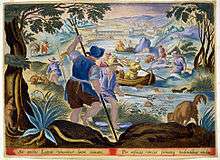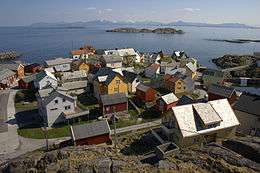Community-supported fishery
A community-supported fishery (CSF) is an alternative business model for selling fresh, locally sourced seafood. CSF programs, modeled after increasingly popular community-supported agriculture programs, offer members weekly shares of fresh seafood for a pre-paid membership fee. The first CSF program was started in Port Clyde, Maine, in 2007, and similar CSF programs have since been started across the United States and in Europe. Community supported fisheries aim to promote a positive relationship between fishermen, consumers, and the ocean by providing high-quality, locally caught seafood to members. CSF programs began as a method to help marine ecosystems recover from the effects of overfishing while maintaining a thriving fishing community.
Structure
In a CSF, consumers sign up as members and pay in advance for a “share” of seafood, to be delivered weekly. Generally, each share is measured by weight but the size of shares offered varies among programs. Many programs offer multiple levels of membership, depending on the size of a share a member wants (i.e., individual share or family share). Each CSF offers a different variety of seafood to its members, based on local regulations, catch size, season, and location.[1] Some CSFs may specialize in a specific species of seafood, while others may offer a variety of species based on what is currently available.[1] Though many aspects of CSF programs are unique to specific programs, according to the organization Local Catch, there are 5 main elements that unite all CSF programs:
- To establish a transparent chain-of-custody from boat to plate
- To increase access to premium, locally-caught seafood
- To ensure fishers receive a fair price for their catch that reflects the value of their work
- To engage fishers and community members in more robust, viable, local food systems
- To provide a framework through which fishers and customers alike can creatively steward marine resources[2]
Combined, these elements are often considered the basis for conducting the program on a triple bottom line.
Triple bottom line
Community-supported fishery programs operate on a triple bottom line, which incorporates environmental stewardship, economic stability, and social improvements as goals of their business. The success of each aspect is intricately tied to the success of other two, creating a balance that benefits the fishermen, the consumers, and the health of the environment.
Economic Stability
CSFs began primarily with economic stability as a goal. Due to increased regulatory pressures, many small fishing communities were on the verge of disappearing. By creating a local market for seafood that bypassed the traditionally lengthy seafood supply chain, fishermen were able to continue working. Fishermen were also able to obtain a small price premium for their catch, which allowed them to be more flexible in their fishing practices. Further, by paying in advance, consumers are participating in a form of risk sharing with fishermen, who are assured of a buyer for their catch before they leave the harbor.[3]
Social improvements
In creating a program that provides a direct connection between fishermen and consumers, CSF programs aim to rebuild the relationship between people and the food they eat. This relationship was lost with the rise of commercial fishing practices. Building a local food community is good for not only for community relations, but also for supporting local economies: people will be more inclined to support their neighbors only if they actually know their neighbors.
Environmental stewardship
In creating economic and social benefits, fishermen are then able to become stewards of marine ecosystem health, by utilizing practices that better support the fish populations they target. Specifically, many fishermen are able to alter their target species based on what is abundant, not what is in high demand by the larger supply chain. This allows fishermen to get a price that is closer to the cost of harvesting, gives more exploited fish a break, and provides members with more diversity in product. Often the fishermen know what the least destructive method of fishing is, but in the past have been pressured by market demands to go after only the highest priced fish (which are generally those most at risk for exploitation). Besides being able to focus on more abundant fish species, CSF fisheries can also supply all fish species that are caught to their consumers, as they can select a range of fish. This effectively eliminates by-catch.[4]
Pilot Projects
A 2006 study administered by North Carolina Sea Grant identified community-supported fisheries as a new direct marketing strategy to increase demand for local seafood in Carteret County, North Carolina.[5] This led to the design of the nation’s first-ever research project on community-supported fisheries and a 2007 pilot CSF for Carteret County shrimp.[6] While this pilot CSF did not take off with consumers, it did garner the attention of the Gulf of Maine Research Institute and the Island Institute, who invited the researchers to present the CSF idea to local fishermen, including some belonging to the Midcoast Fishermen's Cooperative.[7]
The first successful community-supported fishery program began in 2007 as a pilot project out of Port Clyde, when the Mid-Coast Fishermen’s Cooperative teamed up with the First Universalist Church in Rockland, Maine, to deliver fresh shrimp. The pilot proved so successful that in the spring of 2008, the Port Clyde community expanded beyond shrimp and Port Clyde Fresh Catch became a viable business. Today, this program delivers fresh, Maine caught shrimp and groundfish to several different locations throughout their local community. In addition, the Midcoast Fishermen's Coop has opened a processing center where they pick shrimp and fillet fish.[8]
Local Catch
Local Catch is a network started in the United States in 2011. It aims to connect consumers to CSF programs. Local Catch acts as an "online network seeking to increase the visibility of CSFs".[2] The site provides a list of current CSF programs in operation as well as a locator tool to help consumers find a program in their area. As of May 2013, Local Catch listed 32 programs in operation.
Challenges
Some challenges that have been identified with CSF programs are the following:
- Scale- Some have questioned how much of an effect a small-scale program can have on an issue that is global in scale and complexity. Further, because most CSF programs are still in their beginning stages, they often cannot fully support all the fishermen in their community, who must continue to rely on the unpredictable nature of the traditional supply chain.
- Effectiveness- While it is admirable that CSFs are striving to meet a triple bottom line, there is not quantitative evidence that they are actually providing the benefits they claim. However at least one CSF program, Monterey Bay Local Catch, has begun the process to create criteria for measuring the impact of CSF programs on economic, social, and environmental factors.[9]
See also
References
Notes
- 1 2 Witter, Allison. (2012) "Local Seafood Movements and Seafood Sustainability in North America."
- 1 2 http://www.localcatch.org/csf.html
- ↑ Brinson, A. et al. (2011). Direct marketing strategies: The rise of community supported fishery programs. Marine Policy 35 542–548
- ↑ CSF able to eliminate by-catch
- ↑ Andreatta, S. (2007) Harnessing Consumer Preferences to Create New Markets for North Carolina Seafood. Fishery Resource Grant Program.
- ↑ Andreatta, S. (2008) Harnessing Consumer Preferences to Create New Markets for North Carolina Seafood - Year Two. Fishery Resource Grant Program.
- ↑ Landis, Benjamin Young (2010). Community Supported Ingenuity. Coastwatch magazine.
- ↑ Campbell, D. (2008) Community-supported Fishery Project: Charting a New Course. Rural Cooperatives. US Department of Agriculture.
- ↑ NFWF Announces 2013 Grants for Sustainable Fisheries. April 30, 2013. Scaling 'Local Catch Monterey Bay' to Serve Neighboring Community Fishing Associations (CA). National Fish and Wildlife Foundation.
Further reading
- McGoodwin JR (2001) Understanding the cultures of fishing communities. A key to fisheries management and food security FAO Fisheries, Technical Paper 401. ISBN 978-92-5-104606-7.
- A Growing Movement for Community Supported Fisheries New York Times, October 2012
- Beyond Red Lists: The Power of Community Supported Fisheries, Grist, 2012
- Local Co-op Helping Keep Alive the Fishing Community
- Cape Ann Fresh Catch Earns New Honor
- The Food Staff's Favorite Things of 2009 - Community Supported Fisheries
- Community Supported Ingenuity, Coastwatch, Winter 2010
- Keeping Local Seafood Afloat: Workshop Explores Consumer Trends And Marketing Strategies Coastwatch, Early Summer 2008
- Carteret Catch: New Marketing Project Promotes Local Seafood Coastwatch, Holiday 2005
- Boat-to-Table Fishing CSAs Catching On YES! Magazine, by Ellen Tyler and Daniel Fireside, Winter 2010
- Community-Supported Fisheries EcoTippingPoints.org
External links
- Local Catch.org, a CSF network in the US
- Port Clyde Fresh Catch, Maine
- Social Network for Fishermen’s associations. Mobile Maritime Hub 2009-2050, European Union

